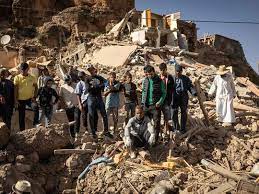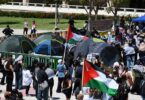Fawaz Turki
Shock-and-Awe, we one and all know by now, is a concept formulated by analysts at the US Defense Department in 1996 that refers to a military strategy based on the use of overwhelming power and spectacular displays of force intended to scare the bejesus out of the enemy, inflict great destruction on his property, visit mayhem on his land, paralyse his perception of reality and destroy his morale.
But the devastation wreaked by that strategy, widely shown during the 2003 Iraq War, pales before the shocking and awesome devastation that an earthquake with a magnitude of 6.8, such as the one that hit Morocco on Friday, can wreak in less than 10 seconds on an unsuspecting community whose members had innocently been preparing to go to bed a few minutes after the hour struck 11pm. That is when the quake also struck, with its centre being the Atlas Mountains, inhabited by Berber farmers since Neolithic times, a region whose self-given name is Amazigh. And it was there, in the region’s isolated and hard-to-access towns and villages, where the worst material destruction and human suffering took place.
The magnitude of the quake was strong enough to drive its way to the ancient city of Marrakesh – an economic hub and popular tourist destination about 45 miles due southeast of the mountains, founded in 1070 by Emir Abu Bakr Ibn Omar, a Berber chieftain – and rip through its centuries-old quarter, Medina, a Unesco World Heritage site, irreparably destroying uncounted historical structures. Look, a long list of natural disasters, like floods, tsunamis, hurricanes, volcanic eruptions, forest fires and, in this case, earthquakes, have been common occurrences in human history – indeed long before human history began to be written by humans about their existence on this planet they conceitedly call their own.
But among all these calamities, earthquakes stand out, characterised as they are not so much by their fury – though that clearly packs a punch – but by their dreadful suddenness and unpredictability. After all, all it takes for an earthquake to wreak havoc, install terror, topple buildings and erase whole towns from the face of the Earth, while it went about snuffing out countless human lives, is mere seconds. The death toll in Morocco has grown into the thousands as has grown in equal measure that of the injured. And pledges by the international community have poured in.
Disasters strike nations all the time, and in our time nations are founded on the principle that it is a nation’s responsibility to protect, among other things, citizens’ lives and property. In the US, for example, the Federal Emergency Management Agency (FEMA) is the living embodiment of that principle, namely, the government’s core responsibility to promptly come to the aid of its citizens in moments of crisis, in particular when natural disasters hit. According to the International Federation of Red Cross and Red Crescent Societies, the world’s largest humanitarian organisation, active in more than 191 countries and bringing together more than 16 million volunteers “for the good of humanity”, many developing nations in the Global South just do not have the resources to adequately deal with the massively complex problems that arise in the wake of a natural disaster, which is where international aid becomes both crucial and indispensable, helping a nation, to bury its dead, heal its wounds, rebuild its infrastructure and, well, recover from the shock and awe inflicted upon its national soul.
All that is fine. It’s all well and good. What passes somewhat unnoticed by us, however, as we review the charred landscape left in the wake of calamitous disasters, anywhere in the world, is the enduring emotional pain suffered by the survivors – pain that dogs them for years, even decades. The way traumatised people experience that kind of trauma, we are told by psychologists who specialise in Post Traumatic Stress Disorder (PTSD), gives rise to a complicated dynamic in the victim’s consciousness, which these researchers have chosen to call “dissociation” – the attempt by the mind to dissociate itself from the unbearable, unspeakable truth of what it had stored in its memory bank.
But the more these survivors try to “dissociate”, to exorcise these tormenting images clinging to them like barnacles clinging onto the hull of a ship, the more they find themselves reliving the terror of what they had been witness to through nightmares in their sleep and haunting flashbacks in their waking hours. “The percentage of people who reported symptoms of psychological distress and shock was considerable”, we read in a report released in March by the World Health Organisation (WHO), about the state of mind of survivors of the recent quake in Turkey and northern Syria. “The symptoms included a tendency to burst into tears, fits of rage, eating disorders and changes in their sleeping habits, often punctuated by horrific recollections of the traumatic events they had witnessed or themselves experienced”. As I write this, the first 72 hours that followed the quake in Morocco – the most critical period for finding people trapped in the rubble before life expires out of them – have long passed. The chance of finding survivors there still clinging to life has diminished considerably. We are left then only with those other, traumatised survivors, clinging to life in their own way, to save.
Gulf News







